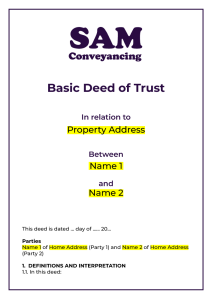Transfer Ownership of House to Spouse
Transferring property ownership, or a share of it, to your spouse or civil partner is a common strategy, primarily to improve Income Tax efficiency on rental properties (Buy-to-Let).
A transfer between spouses is treated on a ‘no gain, no loss’ basis for tax purposes, meaning it is exempt from Capital Gains Tax (CGT). This makes it the simplest way to change the beneficial ownership.
This transfer allows the higher-earning spouse to shift rental income to the lower-earning spouse, potentially utilising their Personal Allowance (£12,570) or Basic Rate Tax Band (£50,270) to reduce the overall tax bill.
The process requires two essential steps to be effective for HMRC:
- A Legal Deed: You must execute a Deed of Assignment or Deed of Trust to formalise the beneficial interest split.
- HMRC Notification: You must file the HMRC Form 17 to declare the unequal income share. Without this, HMRC defaults to a 50/50 split for tax purposes.
Transferring interest to a spouse: Deed of Trust vs. Transfer of Equity
In England and Wales, there are two primary legal methods for transferring a beneficial interest in a property to your spouse or civil partner, a choice often driven by tax planning, particularly for Buy-to-Let properties. The key distinction lies in whether you change the legal ownership or just the beneficial ownership.
Deed of Trust or Deed of Assignment (Transferring Beneficial Interest Only)
A Deed of Trust (also called a Declaration of Trust) or a Deed of Assignment is a legal document that changes the beneficial interest (the right to the value, sale proceeds, and rental income) of a property without changing the legal title registered at HM Land Registry.
Legal Title vs Beneficial Interest
- The Legal Title (whose names are on the Land Registry) remains the same.
- The Beneficial Interest (the right to income and equity) is formally reassigned in percentages, e.g., to a 99%/1% split, to optimise income tax.
This method is highly effective for Buy-to-Let properties, allowing married couples and civil partners to split rental income in unequal shares (e.g., 99%/1%) to utilise the lower-rate tax band of one spouse. This must be formally declared to HMRC using a Form 17.
Since the legal title and the borrower(s) on the mortgage are unchanged, you often do not need the mortgage lender's formal consent, making the process simpler and cheaper than a Transfer of Equity.
Generally, no SDLT is payable on a Deed of Trust between spouses unless the consideration, which includes the transfer of any share of an existing mortgage debt, exceeds the current SDLT threshold (which is £250,000 until March 31, 2025, and £125,000 thereafter).
Transfer of Equity (Changing Legal and Beneficial Interest)
A Transfer of Equity is a legal process using a TR1 form that changes the names of the legal owners on the Land Registry title deeds, simultaneously updating the beneficial ownership.
It adds, removes, or changes the names of the joint owners on the Legal Title at HM Land Registry. This automatically changes the beneficial interest.
If the property has a mortgage, the transfer of equity will require the formal consent of the mortgage lender as the parties legally liable for the debt are changing. The lender will need to assess the financial suitability of the remaining or new legal owner(s).
SDLT is charged on the "chargeable consideration," which includes any money paid and the value of the share of the outstanding mortgage debt that the receiving spouse takes on.
Example: If a property has a £300,000 mortgage and one spouse transfers 50% of the equity to the other, the receiving spouse takes on £150,000 of the mortgage debt.
Since £150,000 is below the £250,000 nil-rate SDLT band (as of the time of writing), no SDLT would be payable, but an SDLT return must still be filed with HMRC.
Crucially, for most BTL tax planning purposes between spouses in England and Wales, a Deed of Trust/Assignment is preferred as it avoids the lengthy and potentially costly process of seeking lender consent and formal Land Registry change, while still achieving the desired income split via Form 17.
Protect your interest in a property and confirm how to sell. Drafted by a solicitor.
The first draft is within 1 to 2 working days* and includes:
- Deposit paid.
- The percentage ownership of each party.
- How to share expenses like the mortgage and bills.
- Share of property income - rent or gain on sale.
- How to sell the property.
- How the property is divided in the event of separation, divorce, or death.
Tax compliance: Why you need HMRC Form 17
Once you establish unequal beneficial interests via a Deed of Trust, you must formally declare this split to HM Revenue & Customs (HMRC) using Form 17.
HMRC's default position is that rental income from joint property owned by married couples or civil partners is split 50/50 for tax purposes.
If your actual beneficial shares are unequal (as declared in your Deed of Trust), you must submit Form 17, along with the Deed, within 60 days of its creation to ensure you are taxed according to your actual shares.
Failing to submit Form 17 means the 50/50 rule will apply, potentially eliminating any tax advantages the Deed of Trust was created to achieve.
Do I need a solicitor to transfer property to my wife?
You need a solicitor to transfer a house to your spouse, whether as simple as drafting a deed or updating the Land Registry.
The process relies on a solicitor to verify your ID with a Land Registry Form ID1 or for their legal drafting to confirm the beneficial interest split.
We specialise in transferring property between spouses, so call us today to find out how we can help you on 0333 344 3234 (local call charges apply) / help@samconveyancing.co.uk, or Ask a Question.
The legal shift to Tenants in Common
When a married couple or civil partners own property in England and Wales, they typically hold it in one of two ways:
Joint Tenants (JT) | Tenants in Common (TIC) |
|---|---|
Joint Tenants (JT)
| Tenants in Common (TIC)
|
To move away from the default 50/50 tax split and allocate rental income to suit your tax positions, you must be registered as Tenants in Common.
Severing the Joint Tenancy
If you currently own the property as Joint Tenants, you must first sever the joint tenancy. This is a straightforward legal process that converts the ownership to Tenants in Common, allowing each owner to hold a specific, measurable share of the beneficial interest.
Once you are Tenants in Common, you can legally create and document the unequal share split that will maximise your tax efficiency.
Costs and fees to transfer beneficial interest
- £275 INC VAT for a Deed of Assignment.
- £260 INC VAT to Sever a Joint Tenancy if you pay a solicitor to update the Land Registry, or free if you do it yourself.
- £399 INC VAT (iii) for a Transfer of Equity if you pay a solicitor to update the Land Registry.
- If you don't have a solicitor to update the Land Registry, you need a Form ID1 at the cost of £100 INC VAT
Risks to consider
Divorce
The risk is that if you break up, the asset forms part of your spouse's assets. This doesn't mean your wife keeps the property after the divorce because all assets are declared as part of the divorce proceedings, and the courts distribute these. However, this means that until the divorce is finalised, any rental income is shared in the split you transferred.
Tax Allowances on Sale
Most transfers for tax purposes assign 100% of the rental income to maximise the lower banding for tax of the lower-earning spouse. This is fine for rental income, but when you come to sell the property, you will miss out on the CGT tax-free allowance of the higher-earning husband.
You can avoid this by drafting a new deed and filing it with HMRC before you sell your buy-to-let. However, you must consider the above, as the transfer can trigger stamp duty.
Andrew started his career in 2000 working within conveyancing solicitor firms and grew hands-on knowledge of a wide variety of conveyancing challenges and solutions. After helping in excess of 50,000 clients in his career, he uses all this experience within his article writing for SAM, mainstream media and his self published book How to Buy a House Without Killing Anyone.
Caragh is an excellent writer and copy editor of books, news articles and editorials. She has written extensively for SAM for a variety of conveyancing, survey, property law and mortgage-related articles.










